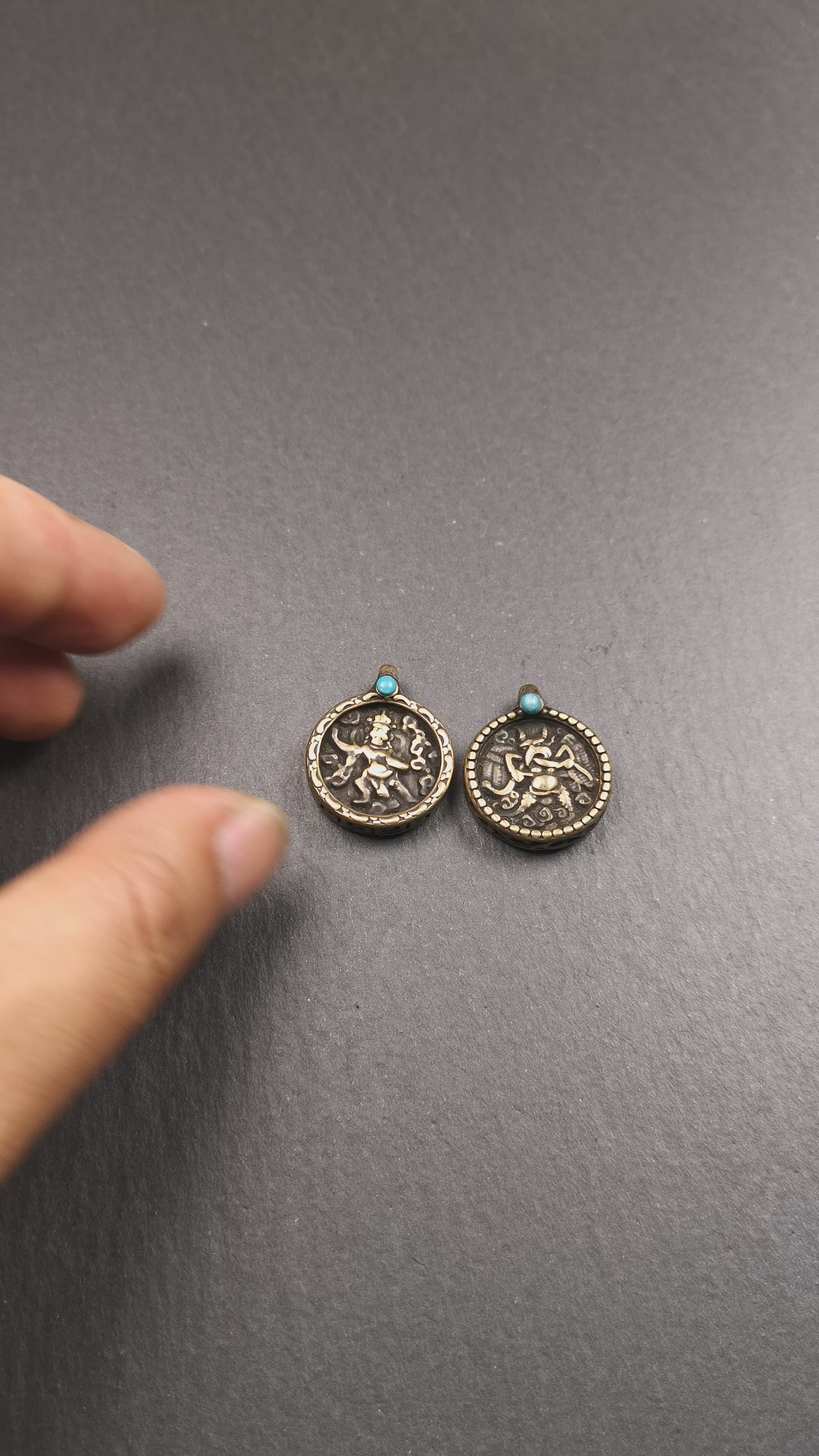Garuda / Vajrapani Amulet - 0.87"
Garuda / Vajrapani Amulet - 0.87"
⏱Vintage: 1990s
☞Handmade: 100%
⚒Materials: Brass
☲Size: 22mm × 6mm
Couldn't load pickup availability
❤These amulets were handmade by Tibetan craftsmen from Tibet in 1990's.
From Hepo Town, Baiyu County, the birthplace of the famous Tibetan handicrafts.
❤The front side of the amulet features Garuda/Vajrapani, while the back side showcases the Cross Vajra. It is exquisitely crafted.Paired with a hand-woven leather cord, it looks very attractive.
You can wear it as amulet, or bag hanging,or just put it on your desk,as an ornament.
❤Details
- 100% Handmade
- Pendant material:brass
- Pattern: Garuda,Vajrapani
- Diameter: 22mm / 0.87 inches
- Thickness: 6mm /0.24 inches
❤ ABOUT VAJRAPANI
Vajrapaṇi (Sanskrit: "Vajra in [his] hand") is one of the earliest-appearing bodhisattvas in Mahayana Buddhism. He is the protector and guide of Gautama Buddha and rose to symbolize the Buddha's power.
Vajrapāni is extensively represented in Buddhist iconography as one of the earliest three protective deities or bodhisattvas surrounding the Buddha. Each of them symbolizes one of the Buddha's virtues: Manjushri manifests all the Buddhas' wisdom, Avalokiteśvara manifests all the Buddhas' immense compassion, and Vajrapāni protects Buddha and manifests all the Buddhas' power as well as the power of all five tathāgatas (Buddhahood of the rank of Buddha).
❤ABOUT GARUDA
Garuda is a legendary bird or bird-like creature in Hindu, Buddhist and Jain faith.He is variously the vehicle mount (vahana) of the Hindu god Vishnu, a dharma-protector and Astasena in Buddhism, and the Yaksha of the Jain Tirthankara Shantinatha.The Brahminy kite is considered as the contemporary representation of Garuda.
Garuda is described as the king of birds and a kite-like figure.He is shown either in zoomorphic form (giant bird with partially open wings) or an anthropomorphic form (man with wings and some bird features). Garuda is generally a protector with the power to swiftly go anywhere, ever watchful and an enemy of the serpent.He is also known as Tarkshya and Vynateya.
IN BUDDHISM
Garuda, also referred to as Garula, are golden-winged birds in Buddhist texts. Under the Buddhist concept of saṃsāra, they are one of the Aṣṭagatyaḥ, the eight classes of inhuman beings. In Buddhist art, they are shown as sitting and listening to the sermons of the Buddha.They are enemies of the Nāgas (snakes) and are sometimes depicted with a serpent held between their claws. Like the Hindu art, both zoomorphic (giant eagle-like bird) and partially anthropomorphic (part bird, part human) iconography is common across Buddhist traditions.
In Buddhism, the Garuda (Sanskrit; Pāli: garuḷā) are enormous predatory birds with a wingspan of 330 yojanas.They are described as beings with intelligence and social organization. They are also sometimes known as suparṇa (Sanskrit; Pāli: supaṇṇa), meaning "well-winged, having good wings". Like the Nāgas, they combine the characteristics of animals and divine beings, and may be considered to be among the lowest of the devas.The Garudas have kings and cities, and at least some of them have the magical power of changing into human form when they wish to have dealings with people. On some occasions Garuda kings have had romances with human women in this form. Their dwellings are in groves of the simbalī, or silk-cotton tree.
The Garuda are enemies to the nāga, a race of intelligent serpent- or dragon-like beings, whom they hunt. The Garudas at one time caught the nāgas by seizing them by their heads; but the nāgas learned that by swallowing large stones, they could make themselves too heavy to be carried by the Garudas, wearing them out and killing them from exhaustion. This secret was divulged to one of the Garudas by the ascetic Karambiya, who taught him how to seize a nāga by the tail and force him to vomit up his stone.
The Garudas were among the beings appointed by Śakra to guard Mount Sumeru and the Trāyastriṃśa heaven from the attacks of the asuras.





















